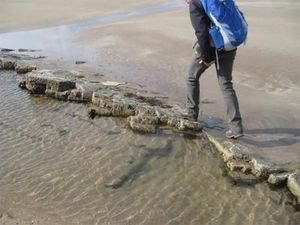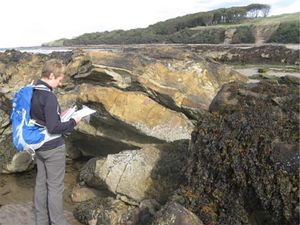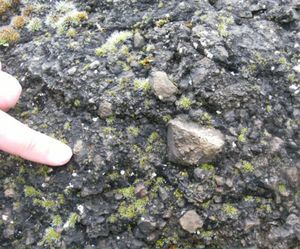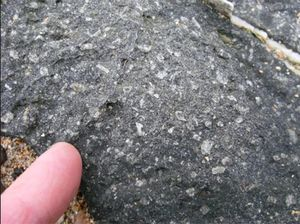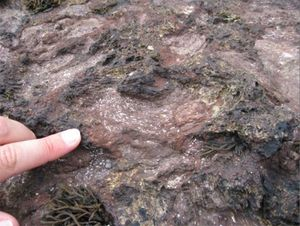OR/14/063 Site assessment - ELC 6: Yellow Craig Shore, North Berwick: Difference between revisions
No edit summary |
m (1 revision imported) |
(No difference)
| |
Latest revision as of 12:55, 16 June 2016
| Whitbread, K, Ellen, R, Callaghan, E, Gordon, J E, and Arkley, S. 2014. East Lothian geodiversity audit. British Geological Survey Internal Report, OR/14/063. |
| ELC_6: Yellow Craig Shore, North Berwick | |
| Site Information | |
| Location and Summary Description: The site comprises a 3 km section of coastline to the west of North Berwick, extending from the Yellow Craig Plantation up to Longskelly Point in the east, to the beach south of Eyebroughy in the west. The site displays strata of the Strathclyde Group, of Lower Carboniferous age. Younger strata of the Gullane Formation are exposed in the west and are underlain by older volcanic rocks of the Garleton Hills Volcanic Formation. | |
| National Grid Reference: Mid-point: 350749, 686061 |
Site type:
|
| Site ownership: Crown Estates | Current use: Open Country |
| Field surveyors: Rachael Ellen, Sarah Arkley and Eileen Callaghan | Current geological designations: North Berwick Coast (GCR ID: 1375); part of Firth of Forth SSSI |
| Date visited: 25th April and 20th August 2014 | Other designations: Firth of Forth SPA and Ramsar, Listed wildlife site (Archerfield), Longniddrie–Berwick AGLV |
| Site Description |
| Background and site area The stretch of coastline between Yellow Craig to the east and Eyebroughy to the west is located to the west of North Berwick. The Broad Sands beach to the north of Yellow Craig is a popular place for walkers and tourists, and there are a number of walking trails and golf courses along the coast to the west. Sedimentary Rocks Volcanic Rocks Yellow Craig Hill, at the eastern edge of the site, is composed of an olivine-microporphyritic, fractured, black basalt which forms part of the Yellow Craig Plantation Plug. There are excellent views from the top of this small hill (a roche moutonnee) toward Fidra and the Broad Sands beach. To the north-east of Yellow Craig Hill are exposures of volcanic breccia (also part of the Yellow Craig Plantation Plug) composed of a brown-grey tuff containing rounded bombs and baked angular blocks (Photo ELC_6 P3). The intertidal rocks of Longskelly Point are composed of an intrusive sheet of fine-grained olivine- basalt, partially vesiculated, with weak polygonal jointing (Photo ELC_6 P4). To the west, a plagioclase-macrophyric basalt (historically known as the Markle Basalt) flow is exposed along the coast. The basalt contains numerous large (<7 mm) feldspar phenocrysts (Photo ELC_6 P5), and has a gnarled and knobbly appearance along the shore. It is also cut in multiple places by calcite veins, and autobrecciated in the upper part of the flow (Photo ELC_6 P6). Overlying the plagioclase-macrophyric basalt is a fissile, dark grey-purple, fine-grained mugearite riddled with calcite veins and vugs. It contains occasional feldspar phenocrysts <4 mm in size, and amygdales filled with calcite <2 cm in diameter. There is localised iron staining along fractures within the mugearite, and excellent examples of concentric iron bands surrounding a core of bleached mugearite (Photo ELC_6 P7), likely representing the weathered top of a mugearite flow within the sequence. The mugearite contains in places rip up clasts of the underlying Markle basalt caught up as the lava flowed across the surface of the older flows. The mugearite is stratigraphically overlain by a trachytic tuff, formed by the deposition of ash following an explosive volcanic eruption. The contact between this tuff and mugearite is clearly defined on the coast to the north of Marine Villa, and is traceable for approximately 150 m along the intertidal platform to the west. At the contact, the mugearite displays an irregular, slaggy amygdaloidal flow top (Photo ELC_6 P8) and is much reddened from its typical dark grey-purple, suggesting weathering of the lava top after emplacement. The overlying red–green trachytic tuff is bedded, with coarse agglomeratic beds and fine ash beds (Photo ELC_6 P9). The coarser volcanic breccia beds locally truncate finer grained (ashy) units, suggesting that mass flows were active during deposition of the tuff (Photo ELC_6 P10). Good exposures through the tuff sequence can be found in low cliffs at the high water mark near Marine Villa. Bedded, yellow-brown tuffs and breccias containing dolomitic fragments form the Weaklaw Vent, exposed at the west of the site. Volcanic vents such as this are likely to have emplaced the locally surrounding lavas and tuffs. Structural Geology Quaternary Deposits and Landforms Access and Additional Information |
| Stratigraphy and Rock Types | |
| Age: Lower Carboniferous | Formation: Gullane Formation |
| Rock type: Sandstone, siltstones, mudstones, occasional tuffs and dolomites | |
| Age: Lower Carboniferous | Formation: Garleton Hills Volcanic Formation |
| Rock type: Trachytic tuff, trachyte, mugearite, plagioclase-macrophyric basalt | |
| Age: Carboniferous | Formation: Southern Scotland Dinantian Plugs and Vents Suite |
| Rock type: Tuff and breccia, olivine-macrophyric basalt | |
| Assessment of Site: Access and Safety | |
| Aspect | Description |
| Road access and parking | Good access from car park located at Yellow Craig Plantation. There are also public toilets available at the car park. |
| Safety of access | Easy access to the shore but all visitors should be aware of the tide times when planning a visit, as most of the exposures are only visible at low tide. |
| Safety of exposure | The rocky exposures have an uneven surface and are often slippery with seaweed. Stout footwear is recommended. The site is exposed to the open sea and the weather forecast should be checked before visits. Some of the exposures are found within low cliffs where potentially loose material may fall, therefore care should be exercised. |
| Access | Access along the foreshore/beach, there are numerous footpaths around the site from the car park. |
| Current condition | The rocks can be covered in barnacles and seaweed. Rocks exposed at the high water mark are mostly free of vegetation, but contain patches of lichen which cover discrete features. |
| Current conflicting activities | None. |
| Restricting conditions | Tide: many of the geological exposures are located in the intertidal range and are therefore covered at high tide. |
| Nature of exposure | Intertidal and beach exposures. |
| Assessment of Site: Culture, Heritage & Economic Value | |
| Aspect | Description |
| Historic, archaeological & literary associations | Robert Louis Stevenson took inspiration for his book ‘Catriona’ from the nearby islands of Fidra and Lamb, and many people believe Fidra was the inspiration for his ‘Treasure Island’. Robert Louis Stevenson also used Marine Villa, a house on the coast in the centre of the site, as the location for his short novel ‘The Pavilion on the Links’. |
| Aesthetic landscape | Coastal. |
| History of Earth Sciences | John Muir Way passes through Yellow Craig Plantation. |
| Economic geology | No known association. |
| Assessment of Site: GeoScientific Merit | ||||
| Rarity | Quality | Literature/Collections | Primary Interest | |
| Lithostratigraphy | Regional | Excellent | X | |
| Sedimentology | Local | Poor | ||
| Igneous/Mineral/Metamorphic Geology | Regional | Excellent | X | |
| Structural Geology | Local | Good | ||
| Palaeontology | ||||
| Geomorphology | Local | Good | ||
| Site Geoscientific Value | ||||
|
The site comprises a complete sequence of extrusive lavas, volcanic tuffs and volcanic vent material, allowing interpretation of the subaerial volcanic environment during the Carboniferous. | ||||
| Assessment of Site: Current site usage | |
| Community | The easy access to the shore and the shore walkway is used regularly by locals. The John Muir Way passes through Yellow Craig Plantation which attracts visitors from further afield. |
| Education | The site displays a variety of features suitable for amateur geologists to study a sequence of igneous rocks representative of a series of volcanic eruptions. This site is an excellent locality for educational fieldwork. The geodiversity of this site could be further promoted by a series of on-site interpretation boards, geo-trail and distribution of geological leaflets. |
| Assessment of Site: Fragility and potential use of the site | |
| Fragility | Weathering/erosion; development of coastal defences may affect the geodiversity. |
| Potential use | On site interpretation, on site geo-trail, school and higher education, research. |
| Geodiversity Summary | |
| This site contains a good variety of geological features associated with volcanic strata. It exposes a sequence of the Lower Carboniferous Garleton Hills Volcanic Formation, along with a small section of the overlying sedimentary Gullane Formation. Features of the volcanic rocks seen indicate the emplacement mechanism and different phases of volcanism, allow interpretation of a sequence of eruption types. The coastline is attractive and has easy access. There are possibilities for adding geological interpretation to this site, especially at the car park of Yellow Craig Plantation, and on top of Yellow Craig Hill. | |

